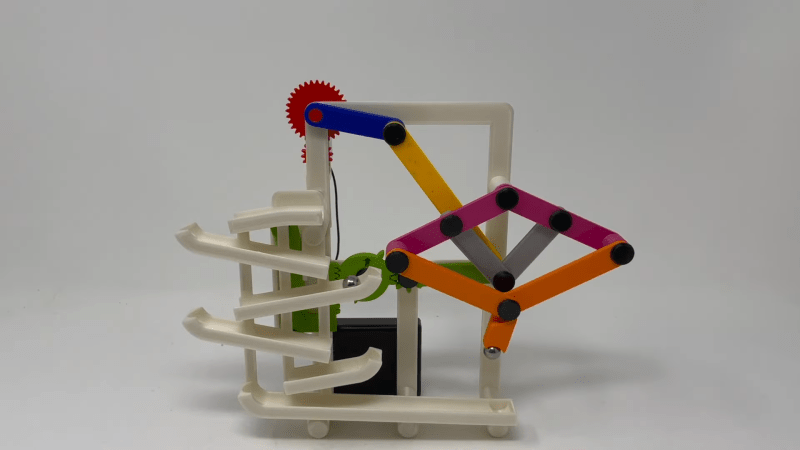There’s seldom anything as joyful and relaxing to watch as a simple marble run. Of course, the thing about letting marbles fall under gravity is that you eventually need to lift them back up again. The Marblevator has a mechanism that does just that.
Overall, the build features a relatively simple marble run. It consists of just six 3D printed ramps which the marble tumbles down in just a few seconds. However, the real magic is in the mechanism that restores the marbles from the bottom of the run all the way back to the top.
A motor turns a gear, which then rotates a crank leading to a multi-link rhombus. On one corner of the rhombus is a small protrusion with a magnet attached, which picks up the marbles from the bottom of the run. As the mechanism turns, the rhombus shifts and brings the marble-carrying arm to the top of the marble run. There, it’s grabbed by another magnet, which holds the marble for a moment before letting it drop back down through the run.
It’s a simple project that nonetheless would make a brilliant desk toy. It’s also a great way to learn about linkage analysis and designing such systems on your own. If you’re big into marble runs, you might also consider procedurally generating them. Video after the break.

















Oh, the little vertical piece with magnet to take it off the arm is clevaaaar. Well done!
Thank you Dave, I’m glad you enjoyed it!
The first link in the article is malformed. “https://www.instructables.com/Marblevator-Pick-and-Place/https://www.youtube.com/watch?time_continue=9&v=At5PaPEwrbE&feature=emb_logo” Or at least Instructables is charfing a 404 on it.
Looks like they accidentally ran the Instructables link and the video link together.
If you separate the former from the later, you will get the Instructables page.
Use this:
https://www.instructables.com/Marblevator-Pick-and-Place
Worked for me!
Thanks! Fixed.
yep, should be https://www.instructables.com/Marblevator-Pick-and-Place/
I’ll admit, that’s a linkage I’ve never seen before. Very impressive. Simplicity and function at it’s finest. I’m very tempted to build one for myself. I’m thinking I’ll go with wood rather than plastic.
Thank you CRJEEA, my father designed a similar mechanism some 50 years ago, and I employed it in this model.
Love that mechanism. I hope you really run with it and make a marblevator with multiple such pick and place arms, one handing the ball over to the next. Such a pleasant motion to watch!
It isn’t the simplest design for this task, but it’s for sure the most beautiful one.
Hi come2,
Sometimes complexity is art, and the grandkids truly enjoyed this one!
Greg
Something isn’t quite the right length. The linkage binds when vertical and all the way to the right, causing the whole thing to jerk and vibrate.
He Gregg,
I design models such as this for others to print, and in this case the gear backlash is set to .5mm which accounts for the motion you observed. In my personal version, the gear backlash is set to .1mm and the extraneous motion you observe is eliminated.
Greg
It’s fabulous, well done!
I’m an AFOL Great Ball Contraption builder and exhibitor, seems like it could be recreated in LEGO so it definitely deserves some thought.
nice, please make a clock ;D
A clock???
:)
Greg
Really well designed!
Thank you Madaeon, I’m glad you enjoyed it!
Greg
Love it! Very cool design. The magnetic on-off lever: brilliant. Rube would be proud.
Thanks Alpha Worm, I appreciate it!
Greg